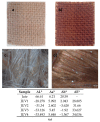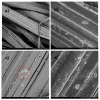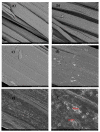Searching for Natural Conductive Fibrous Structures via a Green Sustainable Approach Based on Jute Fibers and Silver Nanoparticles
- PMID: 30966097
- PMCID: PMC6414823
- DOI: 10.3390/polym10010063
Searching for Natural Conductive Fibrous Structures via a Green Sustainable Approach Based on Jute Fibers and Silver Nanoparticles
Abstract
This paper provides new insights regarding jute fibers functionalization with silver nanoparticles (Ag NPs) with improved conductivity values and highlights the sustainability of the processes involved. These NPs were applied onto jute fabrics by two different sustainable methods: ultraviolet (UV) photoreduction and by using polyethylene glycol (PEG) as a reducing agent and stabilizer. Field Emission Scanning Electron Microscopy (FESEM) images demonstrated that the Ag NPs were incorporated on the jute fibers surface by the two different approaches, with sizes ranging from 70 to 100 nm. Diffuse reflectance spectra revealed the plasmon absorption band, corresponding to the formation of metallic Ag NPs, in all samples under study. Attenuated Total Reflectance-Fourier Transform Infrared Spectroscopy (ATR-FTIR) was used to characterize the obtained samples, demonstrating NPs adsorption to the surface of the fibers. The resistivity value obtained by the two-point probe method of the jute fabric without functionalization is about 1.5 × 10⁷ Ω·m, whereas, after NPs functionalization, it decreased almost 15,000 times, reaching a value of 1.0 × 10³ Ω·m. Further research work is being undertaken for improving these values, however, 1000 Ω·m of resistivity (conductivity = 0.001 S/m) is already a very reasonable value when compared with those obtained with other developed systems based on natural fibers. In summary, this work shows that the use of very simple methodologies enabled the functionalization of jute fibers with reasonable values of conductivity. This achievement has a huge potential for use in smart textile composites.
Keywords: PEG; UV photoreduction; electrical conductivity; jute fibers; natural fibers; silver nanoparticles.
Conflict of interest statement
The authors declare no conflict of interest.
Figures













Similar articles
-
Multifunctional Flax Fibres Based on the Combined Effect of Silver and Zinc Oxide (Ag/ZnO) Nanostructures.Nanomaterials (Basel). 2018 Dec 19;8(12):1069. doi: 10.3390/nano8121069. Nanomaterials (Basel). 2018. PMID: 30572578 Free PMC article.
-
Flame-Retardance Functionalization of Jute and Jute-Cotton Fabrics.Polymers (Basel). 2023 Jun 2;15(11):2563. doi: 10.3390/polym15112563. Polymers (Basel). 2023. PMID: 37299362 Free PMC article.
-
Enzymatic Hydrophobic Modification of Jute Fibers via Grafting to Reinforce Composites.Appl Biochem Biotechnol. 2016 Apr;178(8):1612-29. doi: 10.1007/s12010-015-1971-x. Epub 2016 Jan 11. Appl Biochem Biotechnol. 2016. PMID: 26754422 Review.
-
Characterization of KH-560-Modified Jute Fabric/Epoxy Laminated Composites: Surface Structure, and Thermal and Mechanical Properties.Polymers (Basel). 2019 May 1;11(5):769. doi: 10.3390/polym11050769. Polymers (Basel). 2019. PMID: 31052412 Free PMC article.
-
Current Development and Future Perspective on Natural Jute Fibers and Their Biocomposites.Polymers (Basel). 2022 Apr 1;14(7):1445. doi: 10.3390/polym14071445. Polymers (Basel). 2022. PMID: 35406319 Free PMC article. Review.
Cited by
-
A Review of Electro Conductive Textiles Utilizing the Dip-Coating Technique: Their Functionality, Durability and Sustainability.Polymers (Basel). 2022 Nov 3;14(21):4713. doi: 10.3390/polym14214713. Polymers (Basel). 2022. PMID: 36365707 Free PMC article. Review.
-
Multifunctional Flax Fibres Based on the Combined Effect of Silver and Zinc Oxide (Ag/ZnO) Nanostructures.Nanomaterials (Basel). 2018 Dec 19;8(12):1069. doi: 10.3390/nano8121069. Nanomaterials (Basel). 2018. PMID: 30572578 Free PMC article.
-
Green Nanomaterials for Smart Textiles Dedicated to Environmental and Biomedical Applications.Materials (Basel). 2023 May 30;16(11):4075. doi: 10.3390/ma16114075. Materials (Basel). 2023. PMID: 37297209 Free PMC article. Review.
-
The Potential of Graphene Nanoplatelets in the Development of Smart and Multifunctional Ecocomposites.Polymers (Basel). 2020 Sep 24;12(10):2189. doi: 10.3390/polym12102189. Polymers (Basel). 2020. PMID: 32987931 Free PMC article.
-
Protective Multifunctional Fibrous Systems Based on Natural Fibers and Metal Oxide Nanoparticles.Polymers (Basel). 2021 Aug 10;13(16):2654. doi: 10.3390/polym13162654. Polymers (Basel). 2021. PMID: 34451193 Free PMC article. Review.
References
-
- Cui H.-W., Suganuma K., Uchida H. Highly stretchable, electrically conductive textiles fabricated from silver nanowires and cupro fabrics using a simple dipping-drying method. Nano Res. 2015;8:1604–1614. doi: 10.1007/s12274-014-0649-y. - DOI
-
- Miao M., Xin J.H. Engineering of High-Performance Textiles. Woodhead Publishing Ltd.; Cambridge, UK: 2018. pp. 305–334.
-
- Guo L., Bashir T., Bresky E., Persson N.-K. Electroconductive textiles and textile-based electromechanical sensors—Integration in as an approach for smart textiles. In: Koncar V., editor. Smart Textiles and Their Applications. Woodhead Publishing; Oxford, UK: 2016. pp. 657–693. (Woodhead Publishing Series in Textiles).
-
- Kim Y.K., Wang H., Mahmud M.S. Wearable body sensor network for health care applications. In: Koncar V., editor. Smart Textiles and Their Applications. Woodhead Publishing; Oxford, UK: 2016. pp. 161–184. (Woodhead Publishing Series in Textiles).
LinkOut - more resources
Full Text Sources
Miscellaneous

